
Rail Bridges
Rail bridge monitoring with track geometry sensors and train load assessment nationwide.
- Rail Bridge Monitoring
- Displacement Monitoring
- Vibration Monitoring Services
Request a sector consultation
Align your thresholds, instrumentation, and reporting with our PE-led team. We respond within one business day with tailored deployment options.
Rail bridges represent critical infrastructure supporting freight and passenger rail operations nationwide, facing unique structural challenges from heavy train loads, dynamic effects, thermal expansion, and foundation settlement that can affect safety and service reliability. These bridges experience load patterns different from highway bridges, with concentrated axle loads, impact forces from rail joints, and continuous operations creating fatigue concerns. Bridge decks, support structures, and approach tracks must maintain precise alignment while experiencing environmental exposure and seismic activity.
Our monitoring services address the specific concerns of rail operators, transportation authorities, and bridge owners. We deploy sensors that detect early signs of excessive deflection, foundation movement, or connection fatigue before they affect train operations or safety. This proactive approach supports compliance with FRA regulations, AREMA standards, and state requirements while enabling data-driven decisions about maintenance scheduling and load rating updates.
Nationwide deployment ensures consistent monitoring standards across diverse rail environments, from heavy freight corridors in the Midwest to commuter rail lines in urban areas. We work with rail engineers to establish alert thresholds that trigger immediate responses to potential structural concerns, reducing service disruptions and ensuring continuous safe train operations.
Popular Services in This Sector
Rail Bridge Monitoring
Rail bridges require specialized monitoring for heavy train loads and dynamic effects from continuous operations. This service addresses bridge integrity, deflection limits, and connection performance critical for rail safety.
Displacement Monitoring
Foundation settlement and thermal expansion affect bridge alignment and track connections. Displacement sensors track movement patterns to identify areas needing structural reinforcement or track adjustments before service issues occur.
Vibration Monitoring Services
Heavy train loads create vibration that can accelerate fatigue in structural connections. Vibration monitoring detects excessive movement that signals potential structural issues requiring maintenance attention.
Strain Monitoring
Bridge elements experience stress from concentrated train loads and dynamic effects. Strain monitoring identifies fatigue points that could lead to structural failures requiring maintenance or load restrictions.
Inclinometer and Tilt Monitoring
Bridge foundations can develop tilt from settlement or scour. Inclinometers detect movement that affects bridge alignment and track geometry, providing early warning of structural concerns.
Long Term Monitoring and Alerts
Rail bridges require continuous oversight spanning years to track deterioration trends and load response. Long-term monitoring programs provide trend analysis and automated alerts for gradual changes affecting structural integrity.
Frequently Asked Questions
What structural challenges do rail bridges face nationwide?
Rail bridges face heavy train loads, dynamic effects, thermal expansion, and foundation settlement across diverse environments. We provide monitoring that addresses bridge integrity, deflection limits, and connection performance nationwide.
How does monitoring support rail operations without disrupting train service?
We use wireless sensors and remote monitoring to minimize service impact. Our systems nationwide operate continuously during train operations, providing real-time data without affecting schedules or requiring track closures.
What role does bridge monitoring play in rail safety?
Bridge deflection and alignment directly affect train safety and track geometry. Our monitoring provides continuous assessment of bridge conditions and structural elements supporting rail operations nationwide.
How do train loads differ from highway loads in bridge monitoring?
Rail bridges experience concentrated axle loads and continuous operations creating fatigue concerns. Our monitoring tracks structural response to rail-specific loading patterns and provides alerts for conditions requiring maintenance attention nationwide.
Example of Our Capabilities
Sector Type
Rail Bridges
Situation
A freight rail bridge in Illinois shows excessive deflection under heavy train loads
Our Approach
Install displacement sensors on bridge deck, strain gauges on critical connections, and vibration sensors for dynamic load assessment
Expected Outcome
Real-time structural health dashboard showing deflection limits, stress levels, and vibration patterns with alerts for maintenance needs
